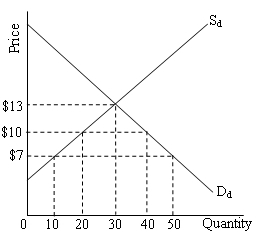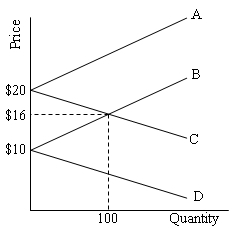 |
| 1 |  | 
In Qatar, a worker can produce either one unit of salt or two units of pepper. In Korea, one worker can produce either two units of salt or three units of pepper. Compared to Qatar, Korea has a comparative advantage in the production of: |
|  | A) | both salt and pepper |
|  | B) | neither salt nor pepper |
|  | C) | salt |
|  | D) | pepper |
|
|
 |
| 2 |  | 
According to the concept of comparative advantage, specialization and trade between two countries will benefit: |
|  | A) | only the country with the lowest labor costs |
|  | B) | both countries, provided neither country has an absolute advantage in both goods |
|  | C) | both countries, provided domestic opportunity costs differ in the two countries |
|  | D) | only the country with the highest tariff rate |
|
|
 |
| 3 |  | 
Answer the next question on the basis of the following production possibilities tables for two countries, North and South Cantina: | North Cantina | | Production possibilities | | A | B | C | D | Smokes | 3 | 2 | 1 | 0 | Mirrors | 0 | 1 | 2 | 3 |
| South Cantina | | Production possibilities | | A | B | C | D | Smokes | 3 | 2 | 1 | 0 | Mirrors | 0 | 3 | 6 | 9 |
Refer to the above tables. If North and South Cantina engage in trade, the terms of trade will be between: |
|  | A) | 1 and 3 mirrors for each smoke |
|  | B) | 2 and 3 smokes for each mirror |
|  | C) | 2/3 and 3/2 smokes for each mirror |
|  | D) | 3 and 9 mirrors for each smoke |
|
|
 |
| 4 |  | 
Use the following diagram to answer the next question.
 <a onClick="window.open('/olcweb/cgi/pluginpop.cgi?it=jpg::::/sites/dl/free/0073365955/627595/q_04.jpg','popWin', 'width=NaN,height=NaN,resizable,scrollbars');" href="#"><img valign="absmiddle" height="16" width="16" border="0" src="/olcweb/styles/shared/linkicons/image.gif"> (18.0K)</a> <a onClick="window.open('/olcweb/cgi/pluginpop.cgi?it=jpg::::/sites/dl/free/0073365955/627595/q_04.jpg','popWin', 'width=NaN,height=NaN,resizable,scrollbars');" href="#"><img valign="absmiddle" height="16" width="16" border="0" src="/olcweb/styles/shared/linkicons/image.gif"> (18.0K)</a>
Refer to the above diagram, wherein Sd and Dd are the domestic supply and demand for a product. If the world price for this product is $10, this country will: |
|  | A) | export 20 units |
|  | B) | export 40 units |
|  | C) | import 20 units |
|  | D) | import 40 units |
|
|
 |
| 5 |  | 
Answer the next question based on the following diagram.
 <a onClick="window.open('/olcweb/cgi/pluginpop.cgi?it=jpg::::/sites/dl/free/0073365955/627595/q_05.jpg','popWin', 'width=NaN,height=NaN,resizable,scrollbars');" href="#"><img valign="absmiddle" height="16" width="16" border="0" src="/olcweb/styles/shared/linkicons/image.gif"> (14.0K)</a> <a onClick="window.open('/olcweb/cgi/pluginpop.cgi?it=jpg::::/sites/dl/free/0073365955/627595/q_05.jpg','popWin', 'width=NaN,height=NaN,resizable,scrollbars');" href="#"><img valign="absmiddle" height="16" width="16" border="0" src="/olcweb/styles/shared/linkicons/image.gif"> (14.0K)</a>
Refer to the diagram. Lines A and C, respectively, represent the export supply curve and import demand curve for the country of Aycee, and lines B and D represent the same for the country of Beedee. In world equilibrium: |
|  | A) | Aycee imports 100 units from Beedee at a price of $16 |
|  | B) | Aycee exports 100 units from Beedee at a price of $20 |
|  | C) | Both Aycee and Beedee import 100 units from the rest of the world at a price of $16 |
|  | D) | Both Aycee and Beedee export 100 units from the rest of the world at a price of $20 |
|
|
 |
| 6 |  | 
A nation's trading possibilities line: |
|  | A) | lies to the right of its production possibilities line |
|  | B) | lies to the left of its production possibilities line |
|  | C) | coincides with its production possibilities line |
|  | D) | illustrates the decrease in world production associated with specialization and exchange |
|
|
 |
| 7 |  | 
"Tariffs are needed to protect workers from ruinous competition from low-wage countries." This statement: |
|  | A) | is correct because trade is based on absolute advantage, not comparative advantage |
|  | B) | is faulty because comparative advantage makes trade mutually beneficial |
|  | C) | is correct because trade lowers domestic labor productivity and living standards |
|  | D) | is faulty because wage rates and labor productivity are inversely related |
|
|
 |
| 8 |  | 
Two nations, Delta and Gamma, each produce goods X and Y under conditions of constant costs. Assume that by devoting all of its resources to the production of good X, Delta can produce 100 units of X. By devoting all of its resources to Y, Delta can produce 150 Y. The comparable figures for Gamma are 30 X and 30 Y. We can conclude that: |
|  | A) | Delta has a comparative advantage in both X and Y |
|  | B) | Gamma has a comparative advantage in both X and Y |
|  | C) | Delta has a comparative advantage in X and Gamma has a comparative advantage in Y |
|  | D) | Delta has a comparative advantage in Y and Gamma has a comparative advantage in X |
|
|
 |
| 9 |  | 
Answer the next question on the basis of the following domestic supply and demand schedules for aluminum.Domestic quantity supplied | Price | Domestic quantity demanded | 140 | $30 | 60 | 120 | 25 | 80 | 100 | 20 | 100 | 80 | 15 | 120 | 60 | 10 | 140 | 40 | 5 | 160 |
Refer to the data. Suppose the world price of aluminum is $10. The total amount of tax revenue collected with a $5 tariff will be: |
|  | A) | $75 |
|  | B) | $160 |
|  | C) | $200 |
|  | D) | $600 |
|
|
 |
| 10 |  | 
Answer the next question on the basis of the following data for the small hypothetical nations of Alpha and Beta. Qs and Qd are domestic quantities supplied and demanded, respectively.Domestic market for tin, Alpha | | Domestic market for tin, Beta | Qs | P | Qd |
| Qs | P | Qd | 90 | $10 | 50 | | 50 | $10 | 30 | 80 | 8 | 60 | | 40 | 8 | 40 | 70 | 6 | 70 | | 30 | 6 | 50 | 60 | 4 | 80 | | 20 | 4 | 60 | 50 | 2 | 90 | | 10 | 2 | 70 |
Refer to the above data. At a world price of $8: |
|  | A) | Alpha will want to import 20 units of tin |
|  | B) | Beta will want to export 20 units of tin |
|  | C) | Alpha will want to export 20 units of tin |
|  | D) | Beta will want to import 20 units of tin |
|
|

